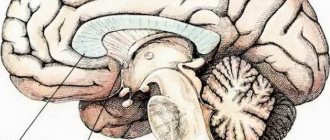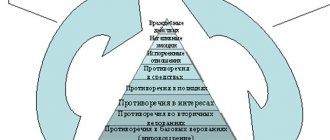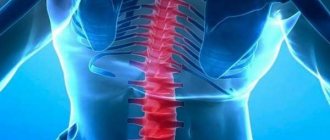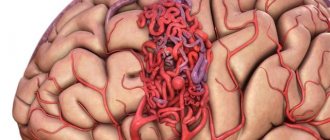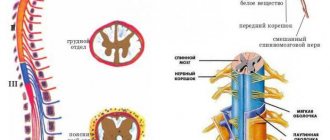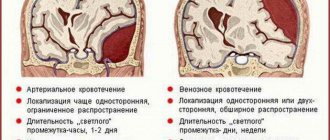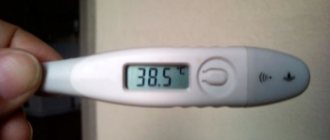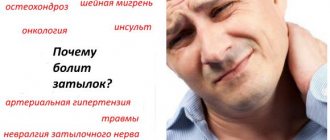What happens if the spinal cord is damaged. Spinal cord lesions
In the cervical region of this department there are the most important ones which are deadly.
Signs and symptoms of damage ↑
The spinal cord consists of gray and white matter. In different departments, their proportional ratio and configuration are different.
The brain is conventionally divided into segments, each of which is anatomically and functionally connected to one pair of spinal nerves.
Fig.: structure of the spinal cord
Such a nerve root, in turn, “serves” one specific area of the body (muscles, skin, bones, internal organs).
Fig.: correspondence of nerves and organs
Nerve fibers passing through the gray matter form a decussation, therefore, if the spinal cord is damaged on the left side, the response symptoms (paralysis, paresis, sensory impairment, autonomic disorders) will appear on the right, and vice versa.
Movement disorders
When the spinal cord is damaged, depending on the level and degree of damage, either complete (paralysis) or partial (paresis) absence of limb movements is observed.
If all 4 limbs are affected, it is called tetraplegia or tetraparesis (depending on the degree), if only 2 are upper or lower - paraplegia or paraparesis.
With lesions of the spinal cord, paralysis or paresis can be flaccid, that is, accompanied by a significant decrease in muscle tone, or spastic, that is, muscle tone increases.
Photo: a child suffering from tetraparesis of the limbs
Motor disturbances with spinal cord lesions are almost always symmetrical - right and left.
Exceptions can only be made in the case of damage to the cauda equina or puncture wounds, when the damage is pinpoint.
Disorders of movement and muscle tone depend on the level of occurrence of the pathology:
- The critical level is the 4th cervical vertebra: damage to the brain before it causes a stop in the innervation of the most important respiratory muscle - the diaphragm, and this leads to the rapid death of the patient.
- Injuries below C4 cause breathing problems, and if the person is treated promptly, he has a chance of survival.
Changing sensitivity
Sensation below the level of spinal cord injury is lost.
If the disease has not specifically affected the spinal cord, but has “passed” along the periphery, a person may feel a decrease in deep and superficial skin sensitivity, up to its complete loss.
Temperature, vibration and pain sensitivity also decreases.
In some cases, paresthesia occurs - tingling, crawling sensation, numbness.
The degree, nature and location of the disorders depend on the anatomy and degree of damage to the spinal cord structure.
Autonomic disorders ↑
These are the following violations:
- increase or decrease in skin temperature;
- increased sweating or dryness of a certain area of the skin;
- increasing or decreasing the formation of sebum in a certain area;
- violation of tissue trophism (because of this, bedsores and trophic ulcers form very quickly);
- stool retention or, conversely, involuntary bowel movement;
- difficulty or, conversely, voluntary urination;
- disturbances in the functioning of the intestines and stomach (decreased production of HCl, decreased production of enzymes).
Pain
As a sign of compression of the spinal cord - it occurs in the midline of the back, pain in the upper extremities - indicates pinching of the cervical nerves, in the lower - as a sign of radicular pain due to osteochondrosis, trauma or tumor of the lumbar region.
To better understand what disorders will result from damage to one or another part of the spinal cord, see the following
Specific syndromes at different levels ↑
Damage to the spinal cord roots
Since almost all roots consist of three types of fibers - motor, sensory and autonomic, when they are damaged, all three of these functions suffer.
Fig.: location of the spinal cord and nerves in the spine
Rarely, only damage to a single fiber may occur, for example, sensitive in herpetic diseases.
Causes
There are different types of spinal cord injuries, so if they occur, it is important to see a doctor immediately. Only a specialist, after conducting a diagnosis, will be able to tell what exactly you have to deal with. It will be useful for people to know the reasons for spinal cord injuries.
Provoking factors can be divided into three categories: traumatic, congenital and pathological. It is definitely worth considering the features of each type in order to understand what you are dealing with.
Traumatic causes include mechanical impacts leading to tissue destruction:
- Fractures. They are extremely dangerous to human health, so when they appear, it is imperative to begin treatment immediately.
- Bruises. They can appear under the influence of negative factors. Even minor bruises can negatively affect the condition of the body, so if they appear, you should be examined by a doctor.
- Hemorrhages. In this case, it is important to identify their cause, as well as eliminate the symptom itself. If you do nothing, then the consequences can be the most unexpected.
- Concussions. They can often be caused by a fall or accident. Symptoms can appear either immediately or after a while.
- Dislocations. A fairly common cause that leads to spinal cord injury. Often it can be obtained by people who engage in professional sports or heavy physical labor.
Often, a spinal injury can occur due to the fact that there are pathologies in the human body. These include tumors that appear in the spine.
We are talking about those pathologies that can affect the spinal cord. Problems with blood circulation caused by various disorders in the body. Due to the deterioration of blood flow, the spine does not receive enough oxygen and nutrients. As a result, his condition worsens significantly.
Congenital spinal cord injuries occur during fetal development. They can also be inherited, therefore, if one of the parents had the disease, then it can later develop in the child. Spinal cord injury is a serious disorder and therefore requires diagnosis. It is important to notice pathological symptoms in time so that you do not have to face serious consequences later.
Primary tumors
They can be benign and malignant.
They can grow both in the spinal canal (intramedullary) and compress the spinal cord from the outside (extramedullary).
Fig.: tumor formation in the spine
Thus, intramedullary tumors are:
- meningiomas (growing from the pia mater of the brain);
- neurofibromas;
- hemangiomas;
- ependymoma;
- astrocytoma;
- medulloblastoma and others.
Extramedullary tumors are mainly tumors of the spine:
- osteoidosteoma;
- osteochondroma;
- osteosarcoma (malignant);
- osteoblastoma;
- angiosarcoma;
- chordoma.
Most often they metastasize to the spinal cord:
- lungs' cancer;
- breast cancer;
- thyroid cancer;
- prostate carcinoma.
Such metastases can occur 10-20 years later, even after radical removal of the primary tumor.
Less commonly, spinal cord metastases from sarcoma or melanoma can be detected.
Multiple sclerosis
This is a disease in which areas of destruction of individual areas of white matter occur.
Fig.: Nerve fiber damage in multiple sclerosis
There are both malignant and benign forms of multiple sclerosis. But, in general, it is progressive.
They can occur both in infectious diseases and in general infectious processes in the body (sepsis).
Inflammation can occur with penetrating injury to the spine, as well as with osteomyelitis of the spinal bones.
These can include penetrating and non-penetrating gunshot wounds and non-gunshot wounds (stab wounds).
Fig.: consequences of traumatic lesions of the spinal cord
There may also be a situation where a spinal injury occurred (even a sudden movement), and the vertebrae already damaged the spinal cord: they either compressed it in the canal, or were able to damage it with fragments during a fracture.
There are hereditary diseases of the spinal cord - for example, Friedreich's ataxia - a disease with an autosomal recessive transmission mechanism, in which deep sensitivity is impaired, ataxia increases, and leg muscles atrophy.
Spinal cord injuries neurology. Terms and Definitions
Instability is a pathological condition characterized by a decrease in the ability of the spinal motion segment to maintain such relationships between the vertebrae that prevent irritation of the spinal cord or roots, and also prevent deformation of the spinal column under the influence of physiological loads.
Paraplegia is a complete loss of functions of the trunk, legs, and pelvic organs resulting from damage to the thoracic, lumbar or sacral segments of the spinal cord, conus or roots of the cauda equina.
Paraparesis is a partial dysfunction of the trunk, legs, and pelvic organs resulting from damage to the thoracic, lumbar, or sacral segments of the spinal cord, conus, or roots of the cauda equina.
Anterior medullary syndrome - incomplete damage to the spinal cord in the form of impaired motor functions, pain and temperature sensitivity while maintaining proprioceptive sensitivity;
Brown-Séquard syndrome is an incomplete (half) injury to the spinal cord, which is characterized by impaired motor functions and proprioceptive sensitivity on the side of the injury and loss of pain and temperature sensitivity on the side opposite to the injury.
Conus and cauda equina syndrome is an incomplete injury to the spinal cord and its roots, which is manifested by flaccid paralysis of the legs, areflexia of the bladder and rectal sphincter.
Spinal cord concussion is a spinal cord injury accompanied by mild neurological disorders, usually regressing within the first 3-7 days and not accompanied by morphological changes in the spinal cord and its roots.
Spinal shock is the absence of spinal cord function below the level of injury for 3-30 days as a result of its swelling, contusion and excessive protective inhibition of nerve cell activity.
Tetraplegia is a complete loss of muscle strength in the arms and legs, torso, dysfunction of the pelvic organs resulting from damage to segments of the spinal cord at the cervical level.
Tetraparesis is a partial impairment of the functions of the arms, legs, torso, and pelvic organs resulting from damage to segments of the spinal cord at the cervical level.
Spinal cord contusion is an injury to the spinal cord that occurs at the time of injury and is accompanied by complete or partial anatomical destruction of its substance with hemorrhages, areas of ischemia, necrosis and regional edema. Manifests itself as neurological disorders lasting more than 7 days.
Centromedullary syndrome is an incomplete injury to the cervical spinal cord, which is characterized by preservation of sensitivity in the sacral segments and a predominance of weakness in the upper extremities over the lower ones.
Injury
Bruises, which are also often called concussions, are most often caused by falls on their feet, whiplash injuries, blows with a blunt object, or “flat” impacts on the surface of the water. Contusions are divided into:
- Lungs - accompanied by hematomas, bruises, pain, restrictions in movement and ruptures of soft tissue structures. Recovery takes up to 2 months.
- Medium - cause compression damage to the vertebral structures, due to which several vertebrae and discs can become displaced and sensitivity in the limbs is partially lost. Recovery lasts up to 4 months.
- Severe - the most severe type of injury. With such a concussion, a person is completely deprived of motor function, malfunctions in the functioning of internal organs occur and severe pain occurs throughout the body. The duration of the recovery period can be up to six months, but it is not possible to eliminate all the consequences of the concussion.
Contusion can affect any part of the spinal column. If the cervical region is concussed, partial paralysis of the arms, pain in the occipital and cervical region, and breathing problems appear; thoracic - coordination is impaired, pain radiates to the left side of the body or becomes encircling, the abdominal reflex is impaired;
Spinal cord injuries neurosurgery. Prognosis and consequences of spinal cord injury
a) Epidemiology. In Europe, the incidence of traumatic spinal cord injury ranges from 10 to 50 cases per million population per year. Most patients are men. The average age has increased over the past decades from 20 to 30-40 years. The most common causes are road traffic accidents and falls.
Tetraplegia (cervical injury) and paraplegia (caudal injury) occur with equal frequency. The incidence of non-traumatic, non-progressive spinal cord injuries is higher than that of traumatic injuries. The causes of non-traumatic spinal cord injuries are prolapsed intervertebral discs, infections, arteriovenous malformations (AVMs), tumors, spinal stenosis, etc.
b) Survival and causes of death. Mortality within the first year after traumatic spinal cord injury was 60-80% before World War II, falling to 30% in the 1960s, 15% in the 1970s, and 6% in the 1980s. The reasons for this are probably related to the creation of specialized units, improved emergency services, antibiotic therapy, etc.
Until the 1970s, the leading causes of death were kidney failure and urinary tract complications. Currently, respiratory complications, especially pneumonia, predominate. Other causes include unintentional injury, suicide, cardiovascular disease and sepsis.
c) Prognosis after traumatic spinal cord injury (SCI). After acute PSM, a phase of spinal shock begins with the absence of reflexes. It can last from several hours to several weeks. This is likely due to the abrupt cessation of supraspinal conduction, which normally maintains a steady state of depolarization in spinal cord motoneurons. In the first weeks after injury due to spinal shock, it is often impossible to predict the functional level of spinal cord injury.
And only after the spinal shock has subsided, reflexes, spasticity and pelvic functions return.
The prognosis is better with incomplete spinal cord injury. Patients with incomplete injury may recover functionally within months or even years after injury. However, if the symptoms of a complete spinal cord injury remain unchanged during the first few weeks, there is little chance of future improvement in function below the level of neurological damage.
d) Classification of spinal cord injuries (SCI). The international standard for neurological classifications is widely accepted. It provides a logical, efficient, accurate and reliable minimum data set for the assessment of spinal cord injuries. In addition, it provides an assessment of functional prognosis.
e) Consequences of spinal cord damage. Spinal cord injury can affect any function below the level of injury and therefore the likelihood of disability, with an overall effect on all functional activities of the individual. Examples of the most common disorders are: - Paresis/paralysis with muscle atrophy, spasticity/spasms, contractures, heterotopic ossification, paralytic scoliosis. — Impaired/lack of sensitivity with the risk of developing bedsores, osteomyelitis, “Marjolin’s ulcer” (squamous cell skin cancer on the periphery of a chronic ulcer or scar). — Respiratory problems with lesions in the cervical or upper thoracic level of the spinal cord. - Cardiovascular diseases with an increased risk of developing deep vein thrombosis and pulmonary embolism, low blood pressure and low pulse in high spinal cord lesions, autonomic dysreflexia in patients with lesions at the T6 level or higher, edema of the lower extremities. — Bladder paresis with urinary incontinence, retention, infection, stone formation, deterioration of kidney function. — Intestinal paresis with incontinence, constipation, hemorrhoids. — Sexual dysfunction and, in addition, impaired fertility in men. — Endocrine and metabolic disorders, in particular in connection with physical activity. — Osteoporosis with an increased risk of lower limb fractures. — Impaired thermoregulation, in particular damage at the cervical level, makes patients very sensitive to ambient temperature. - Widespread pain, both nociceptive in the shoulders and neuropathic below the level of neurological damage.
Distortion
It is a damage (rupture or tear) to the anterior/posterior ligamentous apparatus or articular capsule, in which no further displacement of the vertebral structures occurs. Most often, distortions occur in the cervical spine and are diagnosed mainly in athletes.
Symptoms of distortion include:
- Pain. It can have different strengths and is localized mainly at the point of injury;
- Stiffness in movements;
- Symptomatic picture of radiculitis;
- Edema. It appears over the affected area. When palpating the swelling, the pain intensifies.
The symptoms of distortion are very similar to those of other spinal injuries. Therefore, so that irreparable harm is not caused to the injured person, it is necessary to urgently and correctly provide him with assistance and call doctors who will hospitalize him.
Who has recovered from a spinal cord injury. Treatment methods
How does the spinal cord recover after injury? Based on the fact that these are serious injuries, after the injury you will need to undergo a long course of therapy and rehabilitation. If the operation is successful, the patient is not guaranteed complete restoration of motor function.
Modern rehabilitation methods can increase and improve the prognosis for the restoration of the musculoskeletal system and a speedy recovery. Physical rehabilitation includes:
- Drug treatment;
- exercise therapy;
- Massage;
- Surgical intervention.
Drug treatment involves the use of medications. Hemostatic, anti-inflammatory, and analgesic drugs are used. Hormone therapy reduces swelling, inflammation, and pain shock.
Broad-spectrum antibiotics are used to treat the infectious process. Centrally acting muscle relaxants have a positive effect on the recovery of the patient’s traumatic condition (Mydocalm, Baclofen). For spinal shock, Dopamine, Atropine, and Methylprednisolone are used. The latter remedy helps improve blood supply to the spinal cord. Vitamin E is used as an antioxidant, and the drug Relanium will help eliminate the complications and consequences of hypoxia.
Medical complex
Exercise therapy is aimed at restoring the motor functions of the support system and strengthening the muscular core. To avoid repeated damage, it is advisable to carry out exercises in the pool. The load on the back can be increased over time; further training is carried out in the gym using different exercise equipment.
The set of exercises is effective in the rehabilitation of cervical spinal cord injuries. They should be performed with caution so as not to harm nerve tissue. The exercise is performed under the supervision of a physician or instructor.
Diagnostic methods
When diagnosing spinal cord injuries, it is imperative to take into account how the person received the injury. It is necessary to establish the existing symptoms, and also perform an external examination using palpation. It will be important for the patient to describe his complaints, talk about the intensity and location of painful sensations.
It is also worth mentioning whether there are problems with perception and memory. It is possible that a person suffers from a disorder of skin sensitivity. It is important for doctors to know all this in order to make an accurate diagnosis.
In order to accurately make a diagnosis, certain examinations are used:
- CT and magnetic resonance imaging. These procedures can accurately diagnose spinal cord injuries. The examinations are safe for health and at the same time make it possible to understand whether a person has any abnormalities in the condition of the spine.
- In some cases, myelography is required. This is an x-ray that uses a contrast agent. There are several types of procedures, for example, descending, ascending, and CT myelography.
- The person may be referred for a spondylogram. It is an x-ray that analyzes bone tissue. Can be performed in different projections depending on the person’s condition.
- If you need to assess the condition of muscles and nerve endings, then the person is prescribed electroneuromyography.
- A labial puncture is required to study the composition of the cerebrospinal fluid and understand whether there are any abnormalities in it.
The doctor may refer you for other tests if he deems it necessary. In any case, spinal cord injury requires diagnosis, because it is important to assess the condition of the spinal regions, as well as to understand whether there are complications. You should not wait until your health worsens, because it is easiest to improve a person’s well-being in the early stages of pathology.


